- Introduction
- Historical and Cultural Significance
- The Science Behind Mirages
- Refraction
- Atmospheric Conditions
- Types of Mirages
- The Role of the Environment in Mirage Formation
- The Psychological Aspect of Mirages
- Impact on Navigation and Exploration- Mirage
- Real-world Applications and Observations
- Use in Art and Literature
- Scientific Studies and Observations
Introduction
Overview of Mirages
Mirages are fascinating optical phenomena that create the illusion of distant objects or scenes that are not present or are displaced from their true positions. Visually, they are characterized by shimmering, often watery-looking surfaces or the apparent appearance of features like water bodies on hot surfaces. These ethereal apparitions have captivated observers for centuries, often appearing in arid landscapes, overheated roadways, or near large bodies of water under specific atmospheric conditions. Understanding mirages involves delving into the principles of refraction. Where light bends as it passes through layers of air with different temperatures and thus different densities.
Historical and Cultural Significance
Throughout history and across diverse cultures, mirages have held significant, often mystical, interpretations. Ancient illusory visions, occurring before optical science, were often credited to supernatural forces and divine intervention.
Nomadic peoples traversing arid regions, where mirages are most commonly encountered, often incorporated them into their folklore, myths, and legends. Sailors and explorers, too, have been both misled and mesmerized by mirages at sea. These optical illusions have thus woven their way into the cultural fabric of various societies, influencing their art, literature, and belief systems. The perception of mirages has ranged from omens and hallucinations to intriguing curiosities of nature.
The Science Behind Mirages

Mirages, those captivating optical illusions that deceive our perception of reality, owe their existence to fundamental principles governing the behavior of light as it interacts with the atmosphere. Understanding these principles provides a scientific framework for comprehending the formation and variety of mirages we observe.
Basic Principles of Light
At the heart of mirage formation lies the nature and behavior of light itself.
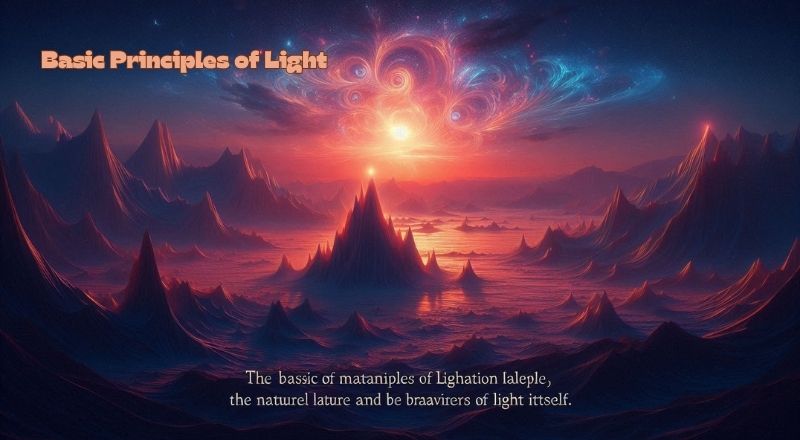
- Nature of Light: Light is a form of electromagnetic radiation, a spectrum of energy that includes radio waves, microwaves, infrared, visible light, ultraviolet, X-rays, and gamma rays. Visible light, the portion of this spectrum detectable by the human eye, exhibits a fascinating duality: it behaves both as a wave and as a particle (photon). The wave nature of light is characterized by its wavelength and frequency.

In contrast, its particle nature explains how light interacts with matter at a fundamental level, transferring energy in discrete packets. In a uniform medium, such as air with consistent temperature and density. Light travels in straight lines, a principle known as rectilinear propagation. This fundamental property allows us to perceive the shapes and positions of objects directly.
- Speed of Light: The speed of light in a vacuum is a fundamental constant in physics, approximately 299,792 kilometers per second (often rounded to 300,000 km/s or denoted as ‘c’). This represents the ultimate speed limit in the universe. Light travels fastest in a vacuum. The speed of light decreases as it passes from one medium to another, such as air, water, or glass.

The medium’s optical density reduces light speed, with higher density causing a greater reduction.
The alteration of light speed as it traverses various media is key to light refraction. The process responsible for mirages.
- Bending of Light: Light refraction, the bending of light, happens when light waves shift direction traveling between media of varying optical densities. The alteration in trajectory arises from the variation in the speed of light as it enters a different medium. Imagine a marching band walking in a straight line that suddenly encounters mud at an angle.

The side that enters the mud first will slow down, causing the entire line to pivot. Similarly, when light encounters a boundary between two media at an angle, the part of the light wave entering the denser medium slows down first, causing the wavefront to change its direction.
Incidence Angle, Reflection, and Transmission:

When a light ray hits the boundary between two different materials, several optical effects can occur. The incidence angle is defined as the angle formed between the incoming light and the perpendicular to the surface, known as the normal. The normal is an imaginary line drawn perpendicular to the surface at the precise point where the light it. A portion of the light will be reflected into the original medium. With the angle of reflection being equal to the angle of incidence.
When light passes into a second medium with a different optical density. A portion is transmitted and refracted, bending at the interface as described by Snell’s Law.
Which mathematically relates the angles of incidence and refraction to the refractive indices of the two media. The refractive index quantifies how much a substance reduces the speed of light as it travels through that substance.
Refraction
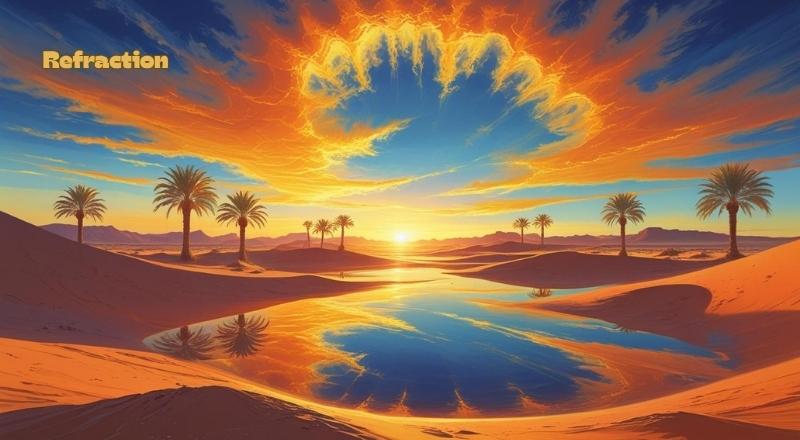
Refraction is the phenomenon where light deviates from its straight path as it transitions from one transparent medium to another. When light transitions into a medium with a different optical density, it changes speed and consequently bends. Optical density signifies the extent to which a material decelerates light. To illustrate, light’s velocity is greater in air compared to its speed through water or glass. When a ray of light strikes the boundary between two media at an angle (other than perpendicular), due to variations in speed across a wavefront, one section progresses faster or slower than another. This disparity leads to a redirection of the entire wavefront, consequently causing the light ray to bend.
The Law of Refraction (Snell’s Law)
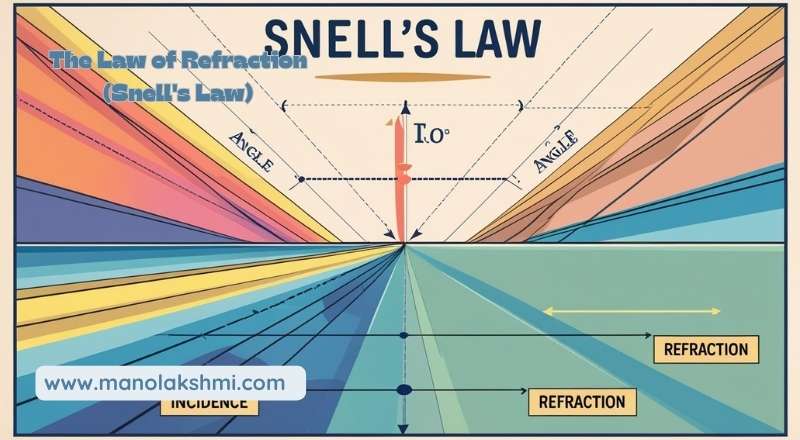
Snell’s Law, describing the extent of light bending at an interface, is attributed to Willebrord Snellius, a Dutch astronomer and mathematician also known as Snell. Snell’s Law mathematically relates the angle of incidence, which is found between the incoming ray and the surface’s perpendicular line, to the angle of refraction, which is measured between the exiting ray and that same perpendicular line. This law also involves the refractive indices of the two media through which the light travels.
The mathematical expression of Snell’s Law is:
( n_1 \sin(\theta_1) = n_2 \sin(\theta_2) )
Where:
- The refractive index of the initial medium, from which light originates, is denoted as \(n_1\).
- The of is represented as $(\theta_1)$.
- The refractive index of the second medium, represented by $n_2$, refers to the measure of refraction in the medium into which light is transmitted.
- The angle of refraction is represented as $(\theta_2)$.
- The active index ($n$) of a medium is a dimensionless measure that represents the ratio by which the velocity of light is in that medium compared to its velocity in a vacuum ($c$). The refractive index represents the ratio of the speed of light in a vacuum to its speed within a given medium (v).
( n \frac{c}{v} )
Materials with higher refractive indices are optically denser, causing light to travel more slowly through them and bend more significantly.
How Refraction Leads to Mirages
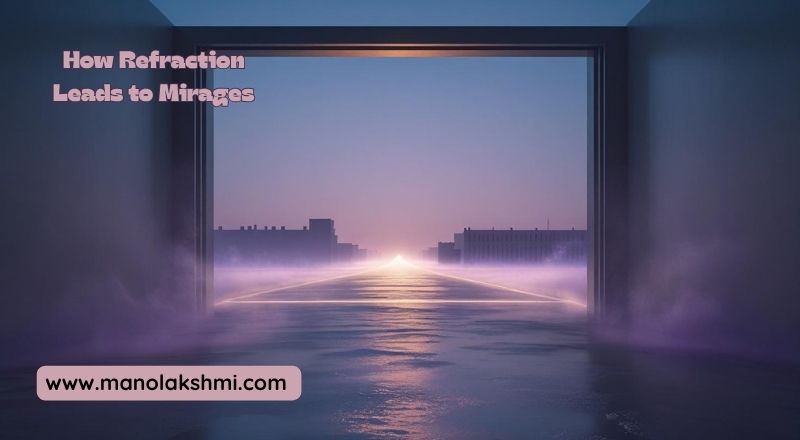
One fascinating natural phenomenon resulting from refraction is the formation of mirages. Mirages are optical illusions that make distant objects appear displaced or distorted, often appearing as if there is water on a dry surface. They occur due to the refraction of light as it passes through air layers of varying temperatures and therefore varying densities.
Near the Earth’s surface, especially on hot days, the air close to the ground can become significantly warmer than the air above it. Due to its lower density compared to cooler air, warm air possesses a marginally smaller refractive index. When light from a distant object travels through these layers of air with different temperatures (and thus different refractive indices), it undergoes a series of refractions.
In the case of a lower mirage (the more common type, making the ground appear wet), light from the sky travels downwards and passes through successively warmer and less dense air layers near the ground. As the light enters each warmer layer, it bends slightly upwards (away from the normal). This continuous bending causes the light rays to curve upwards towards the observer’s eye. The observer’s brain, assuming that light travels in straight lines, perceives the light as originating from below the actual object, creating an inverted image that often resembles a reflection from a pool of water.
An upper mirage occurs when a layer of warm air is above a layer of colder air. In this scenario, light from a distant object traveling upwards passes through the colder, denser air and then into the warmer, less dense air. As it moves into the warmer layer, it moves downward, aligning closer to the norm. Atmospheric refraction bends light, making objects below the horizon visible or distorting those near it, causing them to appear elongated or displaced upwards.
The multiple refractions that light undergoes as it passes through air layers with a temperature gradient are responsible for the shimmering or wavering appearance often associated with mirages. Atmospheric temperature gradient complexities cause diverse mirage effects, including upright and inverted images, and intricate distortions.
Visual Examples of Refraction
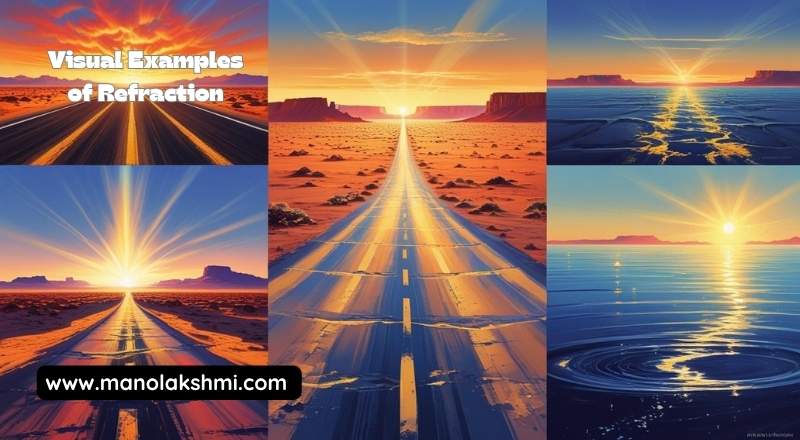
Refraction is a common phenomenon that can be observed in numerous everyday situations:
A straw appears bent when set at an angle to a glass, with the aquatic portion misaligned with the surface of the water. This is because light rays coming from the submerged portion of the straw are refracted. As they pass from the water into the air, changing their direction before reaching our eyes. Our brain interprets these bent rays as originating from a slightly different position, leading to the visual illusion of a bent straw.
The appearance of objects viewed through water:
When looking at objects submerged in water, they often appear closer and larger than they are. This is due to the refraction of light as it leaves the water and enters the air at the water-air interface. The bending of light rays alters the apparent path of light from the object to our eyes, causing our brain to perceive the object as being in a different location and of a different size.
 Lenses focusing light: The curved surfaces of lenses are designed to refract light predictably. Convex lenses have the characteristic of converging parallel light rays, directing them to a single focal point. Unlike convex lenses, concave lenses cause parallel light rays to spread apart (diverge) upon passing through them. This ability to manipulate light through refraction is the fundamental principle behind the operation of eyeglasses, telescopes, microscopes, and cameras.
Lenses focusing light: The curved surfaces of lenses are designed to refract light predictably. Convex lenses have the characteristic of converging parallel light rays, directing them to a single focal point. Unlike convex lenses, concave lenses cause parallel light rays to spread apart (diverge) upon passing through them. This ability to manipulate light through refraction is the fundamental principle behind the operation of eyeglasses, telescopes, microscopes, and cameras.
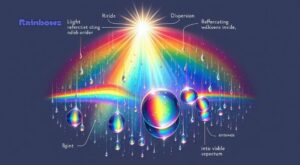 Rainbows: Rainbows are a spectacular example of refraction and dispersion of sunlight through water droplets in the atmosphere. When sunlight enters a spherical raindrop, it is first refracted at the air-water interface, then internally reflected off the back surface of the droplet, and finally refracted again as it exits the droplet. The different wavelengths of light (which we perceive as different colors) are refracted at slightly different angles, causing them to separate and creating the spectrum of colors we see in a rainbow.
Rainbows: Rainbows are a spectacular example of refraction and dispersion of sunlight through water droplets in the atmosphere. When sunlight enters a spherical raindrop, it is first refracted at the air-water interface, then internally reflected off the back surface of the droplet, and finally refracted again as it exits the droplet. The different wavelengths of light (which we perceive as different colors) are refracted at slightly different angles, causing them to separate and creating the spectrum of colors we see in a rainbow.
These examples illustrate the pervasive nature of refraction and its significant role in our perception of the world around us and in various optical technologies.
Atmospheric Conditions

Atmospheric conditions play a crucial role in the propagation of light, significantly influencing optical phenomena observed on Earth. Variations in temperature and air density create a complex and dynamic medium through which light travels, leading to phenomena ranging from simple mirages to the subtle distortion of distant objects.
Temperature Gradients
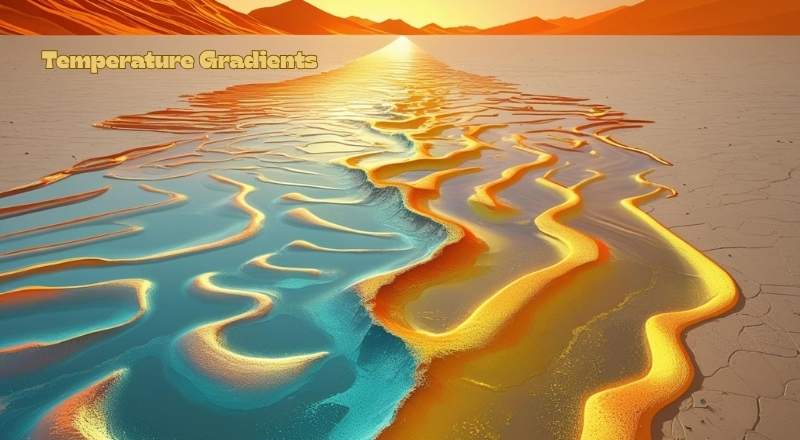
Atmospheric temperature gradients denote the variation of air temperature relative to altitude. Generally, in the troposphere, higher altitudes correspond to lower temperatures. This temperature difference results in variations in air density. Air density fluctuates in response to temperature variations. The density of air increases as it cools, leading to a downward movement. Warm, lighter air rises because of its lower density, in contrast to cooler, denser air. These density differences establish layers of air with varying refractive indices. Light travels at different speeds through air of different densities; it bends towards the denser medium. The gradual temperature change and therefore density create a continuous refraction of light rays as they pass through these layers. Temperature gradient strength is a key factor determining light bending. Greater gradients result in more significant refraction.
Formation of Temperature Inversions
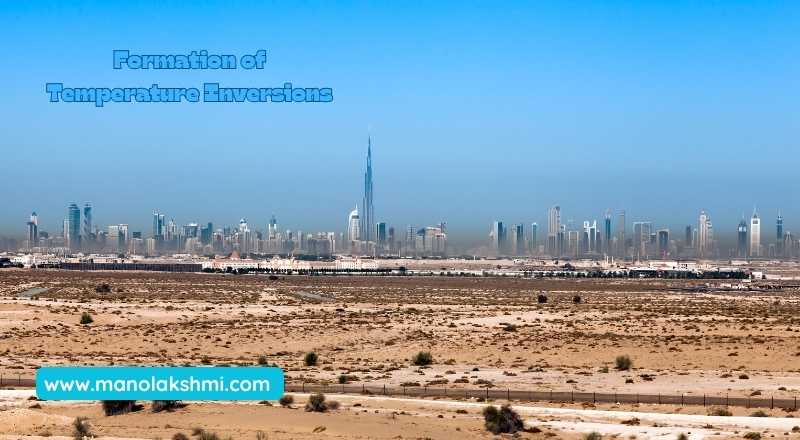
A temperature inversion is an atmospheric phenomenon where the typical temperature profile is reversed; a layer of warmer air sits above a layer of cooler air near the surface. This stable atmospheric condition often forms under clear, calm nights when the ground radiates heat away, cooling the air in contact with it.
The warmer air aloft acts as a cap, preventing vertical mixing. Temperature inversions create a sharp boundary in air density, with denser, cooler air trapped below less dense, warmer air. When light passes through this inversion layer, it undergoes a significant change in direction at the interface between the two air masses, leading to various optical illusions.
For example, temperature inversions are often associated with the formation of superior mirages. Where objects appear displaced upwards or even inverted above their actual position. They can also affect the transmission of sound and the dispersion of pollutants.
Role of Atmospheric Layers

The atmosphere is not a homogeneous medium but consists of distinct layers, each defined by a unique temperature profile and composition. The troposphere, where most weather occurs, exhibits temperature gradients and inversions that significantly influence light propagation.
Located in the upper stratosphere, the ozone layer plays a crucial role in absorbing ultraviolet radiation. This process alters the sunlight spectrum, subsequently affecting the light that reaches the Earth’s surface.
The mesosphere and thermosphere, with their lower densities and varying ionization levels, also interact with electromagnetic radiation. The boundaries between these layers represent changes in atmospheric properties that can refract and reflect light. The interaction of light with these varying atmospheric conditions gives rise to fascinating phenomena such as superior and inferior mirages.
Superior mirages make objects appear higher due to light bending downwards in a temperature inversion. Inferior mirages, seen over hot surfaces, make them seem lower by bending light upwards, creating a water-like illusion.
Impact on Visibility and Color Perception
Atmospheric conditions significantly influence visibility, determining at which objects can be observed. Factors like humidity, the presence of aerosols (tiny particles suspended in the air), and temperature gradients affect how light scatters and is absorbed as it travels through the atmosphere. High humidity and a greater concentration of aerosols increase scattering, reducing visibility and making distant objects appear hazy or less distinct.
Temperature gradients can cause scintillation (twinkling) of distant lights as light rays are refracted by turbulent air with varying densities. Furthermore, atmospheric conditions can influence color perception. Blue and violet light, having shorter wavelengths, undergo more scattering by air molecules (a phenomenon known as Rayleigh scattering), resulting in the sky’s blue appearance.
Due to atmospheric scattering, blue light disperses more readily, especially during sunrise and sunset when sunlight traverses a greater distance through the atmosphere. Consequently, the longer wavelengths of red and orange prevail, giving rise to the vivid colors seen at those times.
Similarly, haze and fog can selectively scatter light, altering the apparent colors of distant objects, making them appear less saturated or shifted towards the color of the scattering medium.
Types of Mirages
Mirages are captivating optical phenomena from the reaction of light as it traverses through layers of air with varying densities. The bending of light rays results in the displacement or distortion of images from far-off objects. Mirages can be broadly categorised into several types. Each with unique characteristics and underlying atmospheric conditions.
Superior Mirages
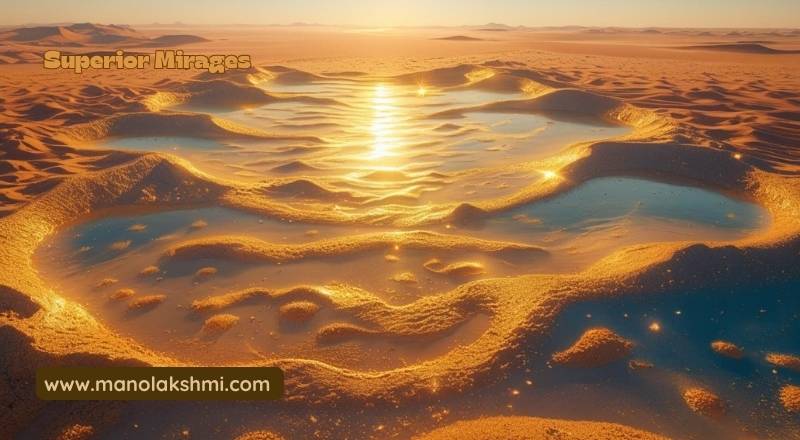
Temperature inversions, where warmer air sits above a significantly colder layer near the ground, cause superior mirages. This temperature gradient causes light rays traveling downwards from a distant object to bend upwards as they enter the denser, colder air. Due to this phenomenon, an observer might see an object’s image displaced upwards from its true location, potentially even appearing to float.
Definition and Characteristics: Superior mirages create images that appear elevated, upright, or sometimes inverted above the true position of the object. A mirage’s clarity and sharpness are directly related to the intensity of the temperature inversion.
Examples:
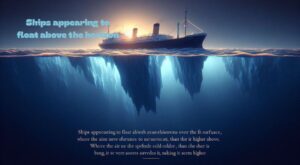 Ships appearing to float above the horizon: This well-known phenomenon frequently takes place over cold ocean waters. Where the air near the surface is substantially colder than the air higher above. The light from the ship bends upwards, making it seem higher.
Ships appearing to float above the horizon: This well-known phenomenon frequently takes place over cold ocean waters. Where the air near the surface is substantially colder than the air higher above. The light from the ship bends upwards, making it seem higher.
The looming of distant land: In polar regions or over large ice fields. Superior mirages can make distant landmasses appear taller and closer than they are.
Seeing objects beyond the Earth’s curvature: Under extreme temperature inversions. It is theoretically possible to see objects that are normally hidden by the Earth’s curvature. Although this is a rare and often distorted view.
Inferior Mirages

Inferior mirages are frequently seen, especially over land on hot, sunny days. They occur when the ground surface becomes intensely heated, warming the layer of air directly above it. Warmer air has a lower density compared to the cooler air situated above it. Light rays travelling downwards from a distant object bend upwards as they pass from the cooler.
Denser air into the warmer, less dense air near the ground. The observer sees the object’s image lower than its real position, like a reflection.
Explanation of Inferior Mirages: The brain interprets the light rays as travelling in a straight line from the perceived image location. In the phenomenon of an inferior mirage, reflected rays create the illusion of a surface resembling water.
Commonly Seen on Hot Surfaces: Roads, deserts, and other dark surfaces absorb a large amount of solar radiation, leading to strong inferior mirages.
Examples:

The “water” seen on a hot road: An inferior mirage, a classic optical illusion, occurs when light from the sky bends upwards due to refraction. The visual illusion of a water pool reflecting the sky is a result of this phenomenon. Distant vehicles may appear to have reflections in this “water”.
Desert mirages: In deserts, the hot sand heats the air above it, causing inferior mirages of distant oases or other landscape features to appear as if reflected in a lake.
Fata Morgana
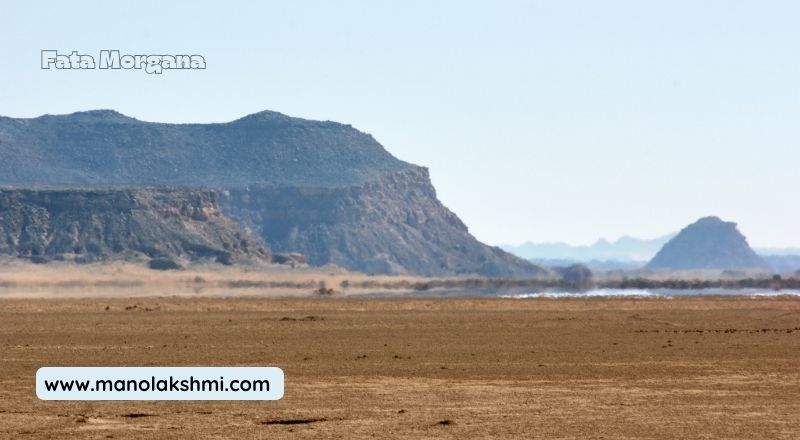
A Fata Morgana is a complex and visually striking superior mirage. It occurs over water or land when there are strong temperature inversions and atmospheric ducting. Which involves layers of air with significantly different refractive indices. This causes light rays to bend in complex ways, resulting in highly distorted and often rapidly changing images that can appear as towering cliffs, castles, or other fantastical shapes.
A Unique Type of Superior Mirage: Unlike simple superior mirages that typically show an elevated. Fata Morgana mirages can combine both upright and inverted sections, as well as stretched and compressed features.
Occurs Over Water or Land: While frequently observed over large bodies of water. Fata Morgana can also occur over land, especially in areas with significant temperature gradients.
Creating Complex Shapes: The multiple layers of air with varying densities act like lenses, bending and distorting the light in intricate patterns. These mirages are often unstable and can change rapidly as atmospheric conditions fluctuate.
Mythological Connections: The name “Fata Morgana” comes from the Italian name for Morgan le Fay. A sorceress in Arthurian legends, who was believed to create illusions in the sky. This reflects the often magical and unreal appearance of these mirages.
Other Mirage Variations

Beyond the primary categories of superior, inferior, and Fata Morgana mirages. Other related optical phenomena are considered variations or are closely linked to mirage formation.
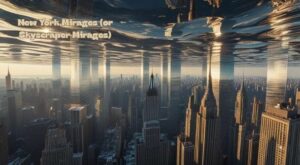 New York Mirages (or Skyscraper Mirages): These occur when sunlight passes through layers of air. With different temperatures above a large, dark surface like a city skyline. Uneven heating can cause distortions in the upper sections of buildings. In visual effects like shimmering or vertical stretching, which give the appearance of.
New York Mirages (or Skyscraper Mirages): These occur when sunlight passes through layers of air. With different temperatures above a large, dark surface like a city skyline. Uneven heating can cause distortions in the upper sections of buildings. In visual effects like shimmering or vertical stretching, which give the appearance of.

Water Ghosts: This term sometimes refers to a type of superior mirage observed over water. Where distant ships or land features appear as faint, ghostly images above the horizon. The term can also be used more broadly to describe other unusual optical phenomena over water.

Lateral Mirages: Sideways bending of light due to horizontal temperature gradients can cause less common horizontal displacement illusions of objects. This phenomenon may occur in the vicinity of a hot object positioned adjacent to a cooler surface.
The Role of the Environment in Mirage Formation

Mirages, fascinating optical phenomena, are heavily influenced by specific environmental conditions. Understanding these conditions is crucial for predicting and interpreting mirage occurrences.
Mirages are not uniformly distributed across the globe. Certain geographic locations exhibit conditions more conducive to their formation.

Deserts: Arid environments, characterized by intense solar radiation and significant temperature gradients near the ground, are prime locations for inferior mirages. The heated sand warms the air above it forming a less dense layer that bends light, frequently creating the illusion of water.
 Highways: Paved surfaces, particularly on sunny days, can become significantly hotter than the surrounding air. This leads to the development of a thin layer of hot, less dense air near the road surface, similar to desert conditions, resulting in the common highway mirage effect.
Highways: Paved surfaces, particularly on sunny days, can become significantly hotter than the surrounding air. This leads to the development of a thin layer of hot, less dense air near the road surface, similar to desert conditions, resulting in the common highway mirage effect.

Coastal Areas: Temperature inversions, where a layer of warm air sits above a layer of cooler air near the sea surface, are common in coastal regions. These inversions can cause superior mirages, where objects appear displaced upwards, sometimes even visible beyond the horizon. Additionally, temperature differences between the land and sea can contribute to complex mirage formations.
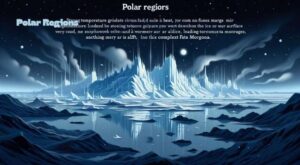
Polar Regions: Although commonly linked to heat, mir can also form in cold environments. Strong temperature gradients can form between very cold air near the ice or snow surface and warmer air aloft, leading to superior mirages, including the complex fata morgana.

Flat Plains and Large Open Areas: Extensive flat terrain allows for the unobstructed development of temperature gradients and minimizes disruption to the light rays, making mirages more easily observable.
Seasonal and Temporal Factors
The occurrence and characteristics of mirages are also subject to variations based on seasonal and temporal changes.
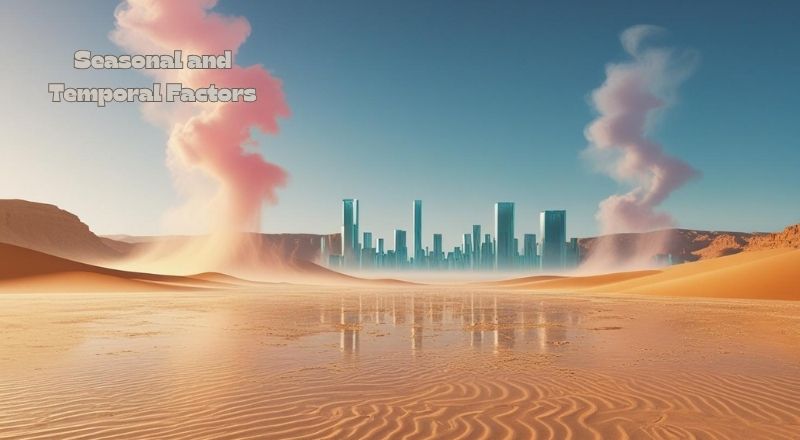
Seasonal Changes: Summer months, with their higher temperatures and increased solar radiation, typically see a greater frequency of inferior mirages in hot regions. Conversely, specific atmospheric conditions during certain seasons might favor temperature inversions and thus superior mirages. Seasonal changes in land and sea temperatures can also influence coastal mirage activity.
 Time of Day: The strongest inferior mirages are often observed during the hottest parts of the day when the temperature difference between the ground and the air above is most pronounced. Sunrise and sunset can also create unique conditions due to the changing angle and intensity of sunlight, sometimes leading to the observation of superior mirages. Diurnal cycles of atmospheric stability play a significant role in the formation and dissipation of mirages.
Time of Day: The strongest inferior mirages are often observed during the hottest parts of the day when the temperature difference between the ground and the air above is most pronounced. Sunrise and sunset can also create unique conditions due to the changing angle and intensity of sunlight, sometimes leading to the observation of superior mirages. Diurnal cycles of atmospheric stability play a significant role in the formation and dissipation of mirages.
Visit our support page: Petrichor: Why does rain smell? The Science Behind Petrichor
Human Factors Influencing Perception
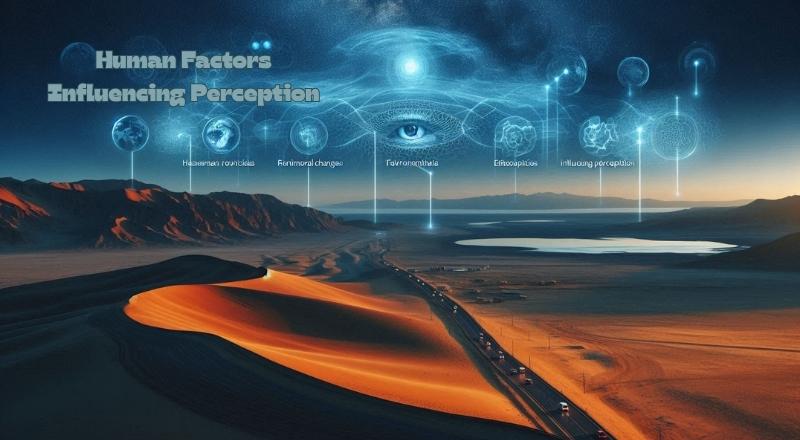
Human activities and environmental changes introduced by humans can also affect the visibility and interpretation of mirages.
Urban Heat Islands: Urban areas are warmer than rural areas, causing temperature gradients that can lead to mirages on urban roads and paved surfaces.
Deforestation and Land Use Change: Alterations to the landscape can affect surface temperatures and air flow patterns, potentially impacting the frequency and intensity of mirages in certain regions. For instance, the removal of vegetation can lead to increased ground surface temperatures.
Air Pollution and Atmospheric Particles: The presence of pollutants and aerosols in the atmosphere can influence the scattering and ref of light. Which may alter the clarity or formation of mirages. High concentrations of particles might obscure or distort the mirage effect.
Observer Location and Perspective: The position and vantage point of an observer significantly influence whether a mirage is visible and how it is perceived. Obstructions, distance, and the angle of observation all play a crucial role.
The Psychological Aspect of Mirages

Human Perception of Illusions
The appearance of a mirage is not solely a physical phenomenon but is deeply intertwined with the complexities of human visual perception and cognitive interpretation. Our brains are constantly processing incomplete or ambiguous sensory information, relying on past experiences and learned patterns to construct a coherent understanding of the world.
Mirages exploit the way light bends due to temperature gradients in the atmosphere, presenting visual cues that our brains misinterpret based on these ingrained expectations. For instance, the common desert mirage of a water body relies on the brain’s association of a smooth, reflective surface with the presence of water.
The shimmering light from the heated ground, bent upwards, mimics this reflective quality, leading to the illusory perception of a pool or lake. Understanding how the visual cortex processes these distorted light rays. How depth perception is affected, and the role of prior knowledge in shaping. The mirage experience are crucial aspects of this psychological dimension.
Furthermore, factors such as the observer’s physical state (e.g., fatigue, dehydration) and attentional focus can influence the likelihood and intensity of perceiving a mirage. Research in cognitive psychology and visual neuroscience can provide valuable insights into the neural mechanisms underlying these perceptual illusions.
Cultural Interpretations of Mirages

Across different cultures and throughout history, the enigmatic appearance of mirages has evoked. A wide range of interpretations, often deeply embedded in folklore, mythology, and religious beliefs. In arid regions, where the sight of illusory water could mean the difference between survival and demise. Mirages might have been viewed as both tantalizing hopes and deceptive tricks of the environment or even supernatural entities.
Some cultures might have personified mirages, attributing their appearance to spirits, deities, or magical forces. Stories and legends could have arisen to explain these seemingly impossible visual phenomena, serving as cautionary tales or offering spiritual significance.
For example, desert nomads might have developed intricate narratives. Around the “water that is not there,” imbuing it with symbolic meaning related to temptation, illusion. Exploring ethnographic records, historical accounts of travelers’ encounters with mirages, and the analysis of folklore. Can reveal the diverse ways in which different societies have made sense of these optical illusions, reflecting their unique worldviews and cultural frameworks.
The evolution of these interpretations alongside the growing scientific understanding of mirages. also presents a fascinating study in the interplay between cultural beliefs and scientific knowledge.
Impact on Navigation and Exploration- Mirage

Historically, mirages have had a significant and often perilous impact on navigation and exploration, particularly in vast, featureless terrains such as deserts and polar regions. For early explorers and travelers who relied heavily on visual landmarks for orientation. The deceptive nature of mirages could lead to significant errors in navigation, wasted resources, and even fatal detours.
The mirage of distant landforms or nonexistent bodies of water could mislead expeditions. Diverting them off course and into perilous or resource-deprived regions.
Conversely, the misinterpretation of real geographical features due to mirage distortion could. Also lead to confusion and misjudgment of distances and directions. Historical accounts from explorers’ journals and logs frequently document encounters with mirages and their often-disorienting effects.
Studying these narratives can provide valuable insights into the challenges faced by early navigators and how they attempted. To cope with the unreliability of visual information in mirage-prone environments. The development of more sophisticated navigational tools and a better understanding of atmospheric optics have mitigated some of these risks in modern times. But the historical impact of mirages on the course of exploration remains a compelling aspect of their significance.
Real-world Applications and Observations
Importance in Navigation and Weather Forecasting
Comprehending the principles underlying mirages transcends curiosity, as it carries practical importance for navigation and forecasting. For centuries, travelers, particularly in arid regions and at sea, have encountered mirages. Recognizing these optical illusions and understanding the atmospheric conditions that cause them can prevent navigational errors.

For instance, a shimmering pool of water on the horizon in the desert might be a superior mirage, indicating extreme heat and temperatures, thereby requiring careful attention to water supplies and travel plans. Similarly, the apparent displacement of distant objects caused by refraction can deceive sailors if they are unfamiliar with the phenomenon. Modern applications involve using atmospheric refraction, the same principle behind mirages, in sophisticated weather forecasting models.
By examining the refraction of light as it traverses various atmospheric layers, meteorologists. Can obtain valuable information about temperature gradients. Variations in air density, and potentially forecast localized weather phenomena such as temperature inversions. Studying the frequency and intensity of mirages in a region can contribute. To a better understanding of its typical atmospheric conditions and seasonal changes.
Use in Art and Literature
Mirages, with their ethereal and often deceptive nature, have long captured the human imagination, permeating art, literature, and popular culture. In art, they have been portrayed to evoke emotions of yearning, illusion, and the intangible essence of reality. Surrealist artists, in particular, have often incorporated mirage-like imagery to challenge perceptions and explore the subconscious. In literature, mirages serve as potent symbols.
They can represent false hopes, unattainable desires, or the distorted perceptions of characters under stress or duress. Desert mirages are frequently used as a motif in narratives of survival and exploration, emphasizing the psychological effects of extreme environments.
Furthermore, the visual spectacle of a mirage, with its shimmering and often dreamlike quality. Provides rich descriptive material for writers seeking to create vivid and evocative scenes. From ancient myths to contemporary novels and films, the mirage continues. To fascinate and inspire creative expression, often serving as a metaphor for the gap between perception and reality.
Scientific Studies and Observations
The study of mirages falls under the broader field of atmospheric optics. A branch of physics concerned with the optical phenomena that occur in the Earth’s atmosphere. Scientific research on mirages involves both theoretical modeling and empirical observation. Scientists use principles of refraction, reflection, and thermodynamics to develop models that explain the formation of different types of mirages, such as inferior, superior, and lateral mirages.
These models take into account factors like temperature gradients, air pressure, and the curvature of the Earth. Observational studies involve documenting mirages through photography, videography, and specialized instruments that can measure atmospheric conditions during their occurrence. Researchers also analyze historical records of mirage sightings to understand long-term atmospheric trends. Advancements in technology, such as sophisticated optical sensors and atmospheric sounding techniques.
Have allowed for more detailed and quantitative studies of mirages. This research contributes not only to a deeper understanding of atmospheric physics. But also has practical applications in fields like remote sensing and the development of algorithms. For correcting atmospheric distortions in astronomical observations.
Visit our support page: Water Cycle Explained: The Lifeblood of Our Planet
